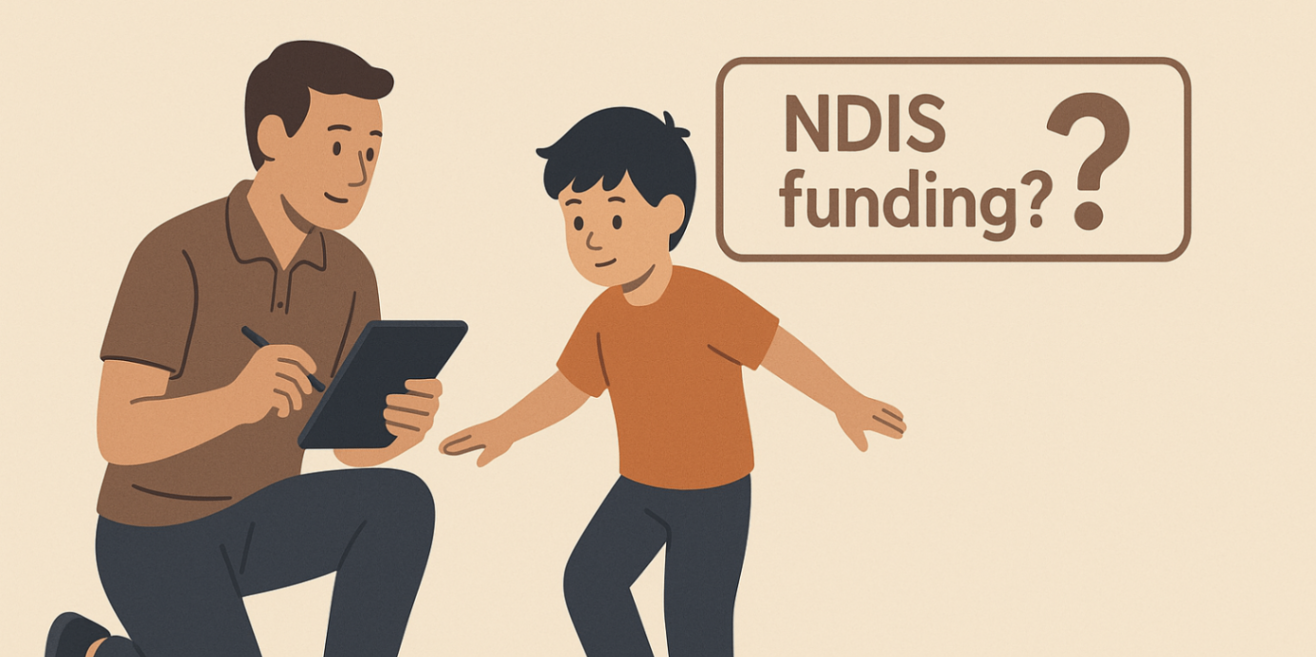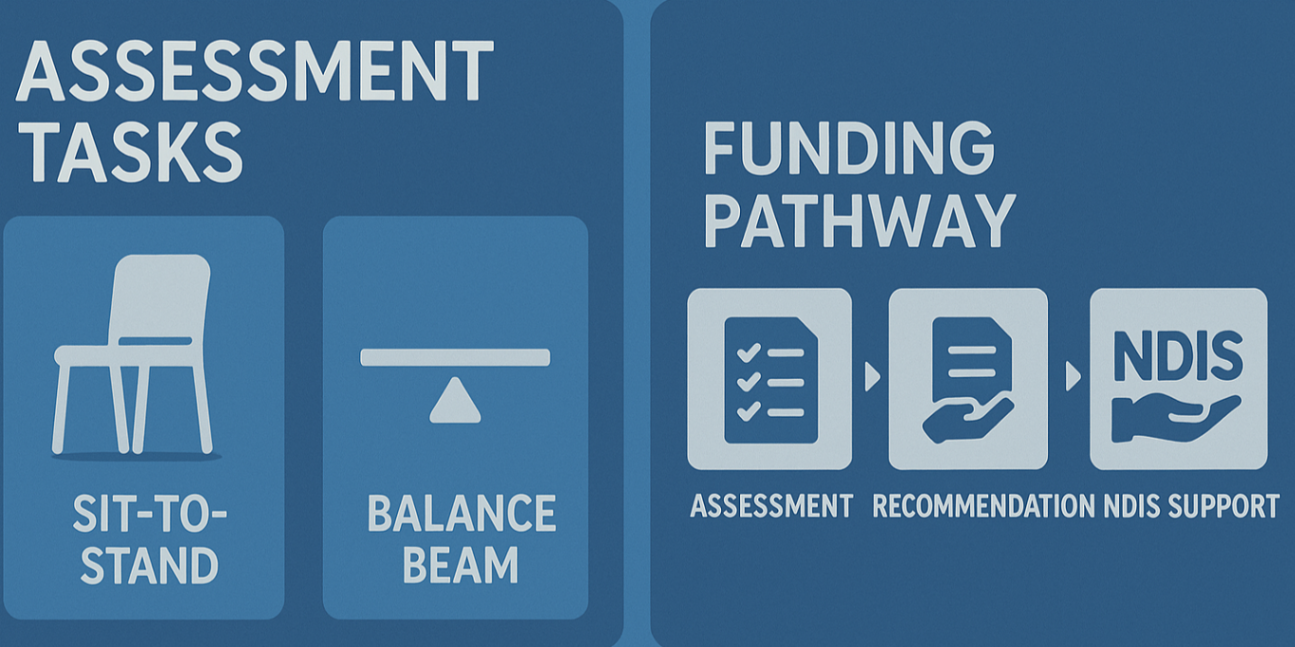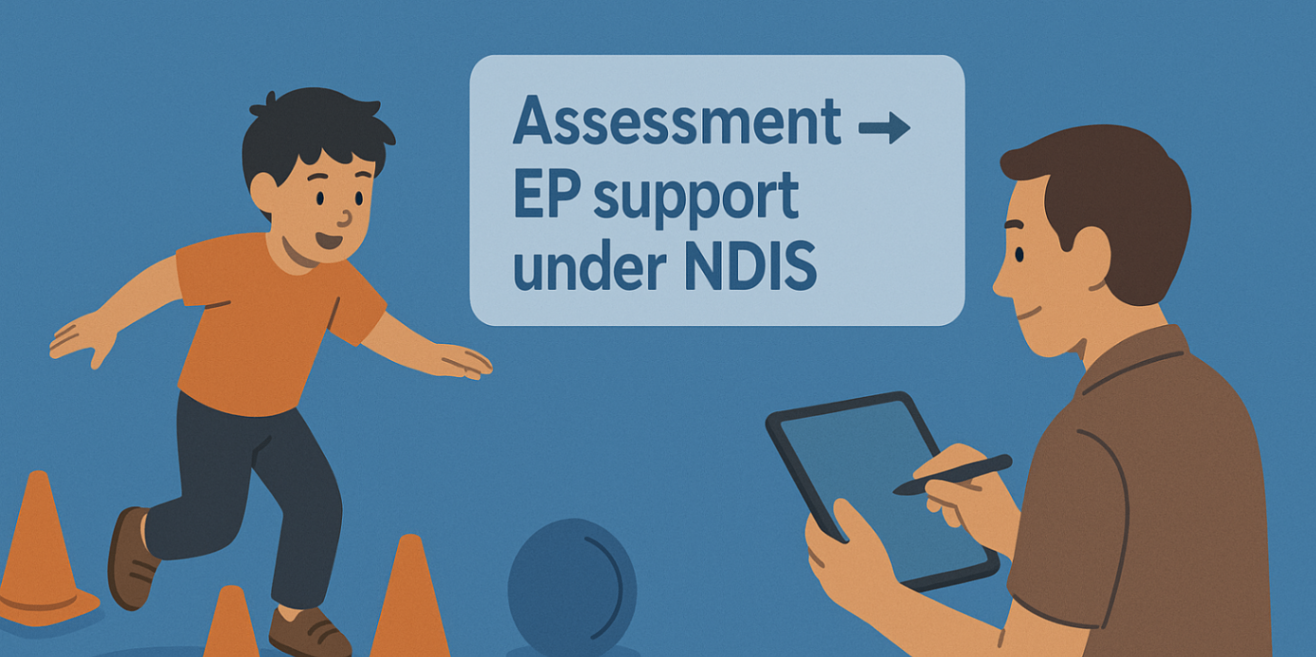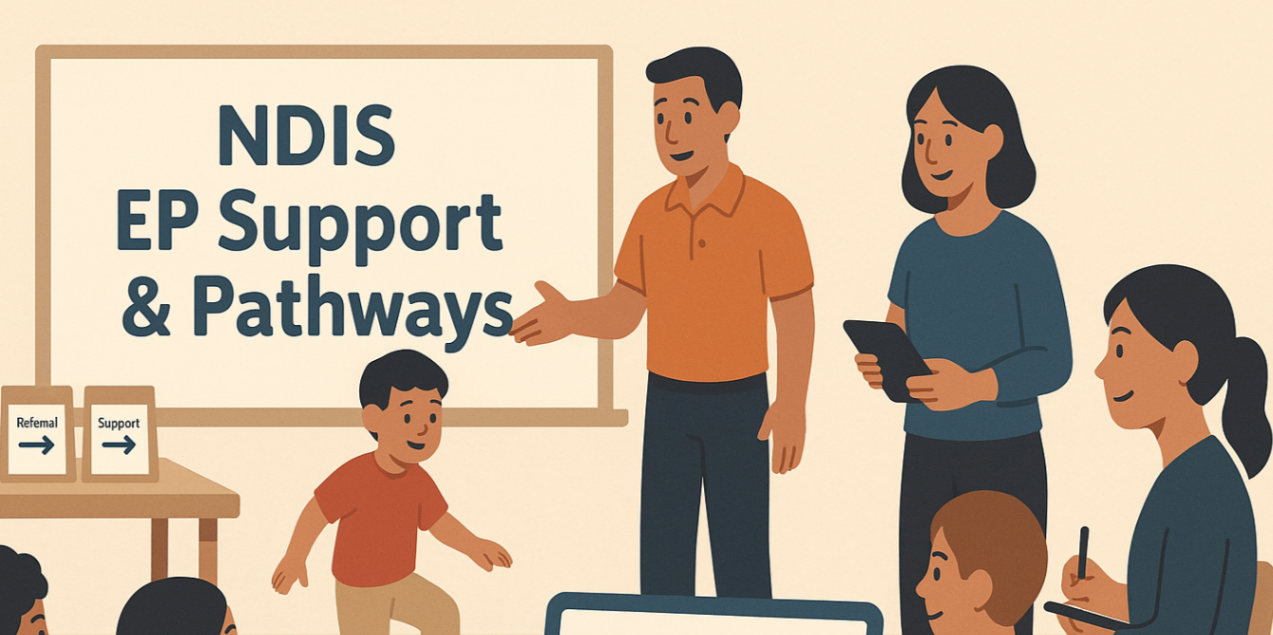
exercise physiology autism: a guide for ndis support
19 August, 2025
Key Highlights
-
Exercise physiology autism programs offer tailored interventions for children with autism spectrum disorder.
-
NDIS funding can be used to access these specialised services under categories like "Improved Health and Wellbeing."
-
Targeted exercise physiology autism programs significantly enhance motor skills, coordination, and physical fitness.
-
Physical activity supports social development by providing opportunities for interaction and communication.
-
An accredited paediatric exercise physiologist autism specialist uses evidence-based techniques to improve emotional regulation and reduce anxiety.
-
Personalised programs are designed around a child's unique needs, interests, and goals.
Introduction
Autism spectrum disorder (ASD) is a neurodevelopmental condition that impacts communication, behaviour, and social interaction. Many children with ASD struggle with motor skills, sensory sensitivities, or social anxiety, making it difficult to join in regular sports or gym programs. However, exercise physiology autism interventions are designed to overcome these barriers. They provide structured, supportive physical activity that improves health, confidence, and participation.
For families in Sydney, including those seeking autism therapy exercise Liverpool services, specialised programs through NDIS exercise physiology for autism can make a profound difference.
Want to understand who is eligible for NDIS-funded exercise physiology and how the process works? Read NDIS-Funded Exercise Physiology — Eligibility & Process on daar for a clear step-by-step guide.
What Is Exercise Physiology and Its Role for Children with Autism

Exercise physiology autism services focus on how movement impacts the body and mind. Unlike general fitness, they are clinically based and tailored to support developmental conditions.
An accredited paediatric exercise physiologist autism expert evaluates motor skills, physical health, and emotional needs to create individualised plans. These programs aren’t just about fitness – they build communication skills, confidence, and independence.
Definition and objectives of exercise physiology
Exercise physiology is one area of health care that helps people by using physical activity as part of therapy. The exercise physiologists are taught in universities and understand how the body reacts when it moves. They use what they know to set up exercise plans for people who need help for different health reasons.
The main goal is not only to help fitness. It is also to reach certain health targets. Some examples are controlling chronic conditions, helping someone after an injury, or working with those who have developmental disabilities. Exercise is used to boost body function, health, and how you feel, and it is done in a way that is backed by facts and done in clinics.
For a child with autism, physical activity can have many aims. These might be to lower repeated actions, help the child sleep better, or improve the coordination they need for daily things. It is a focused way to help people by using movement, so they can have better days.
How exercise physiology differs from general fitness training
While both exercise physiology and general fitness training have physical activity, they are not the same. A personal trainer often helps people to reach their fitness or appearance goals. But exercise specialists are trained to work with those who have complex health problems, including developmental disorders such as autism.
These specialists learn at the university level. They know a lot about both the body and mind in different situations. They are able to plan exercise that is safe and works well for people who may have a tough time taking part. This expert care makes sure the physical activity is not only helpful but also safe to do.
For kids with autism, an exercise physiologist takes things like sensory sensitivities, trouble with movement planning, and feeling nervous around other people into account when creating a plan. This careful way of working and watching over each step is what sets exercise physiology apart from a regular fitness class or personal trainer session.
Relevance to autism spectrum disorder
The connection between exercise physiology autism and autism spectrum disorder is well-documented. Structured programs improve strength, balance, and endurance while reducing anxiety and repetitive behaviours. Studies show that physical activity enhances quality of life for children with autism, which is why autism ndis supports now widely include these services.
Studies show that exercise has positive effects for children with autism spectrum disorder. In one 2018 study, a long-term exercise plan helped kids feel better. It improved their metabolic health and reduced some autistic signs. The study also found that parents thought there was a big increase in their child’s quality of life. [Source: Perceptual and motor skills, https://pubmed.ncbi.nlm.nih.gov/29226773/]
An exercise physiologist can come up with activities that build strength. Exercise can help kids on the autism spectrum practice social skills by making easy chances for them to interact. It gives them a friendly space to learn. Because of this, the effects of exercise physiology are a valuable tool for dealing with the problems that come with autism.
Overview of Autism Spectrum Disorder in Childhood

Autism spectrum disorder is a condition that starts in early childhood. When there is a diagnosis of autism spectrum disorder, families often look for help for their young children. Children may have trouble with social skills, talking with others, and how they act. These problems can also affect their physical health.
There are many young children with autism spectrum disorder who find it hard to take part in group activities or play sports. This can mean they do not get enough physical activity to meet recommended physical activity guidelines. It is important to know what their specific struggles are. This helps to make good solutions, like special exercise programs, for them. In the next parts, we will look at these challenges around low levels of physical activity and other problems more closely.
Common characteristics and challenges
Autism spectrum disorder is a condition that shows up in many different ways for each person. People can have their own mix of things they do well and things that are tough for them. There are some things you see often with autism spectrum, like trouble with social interaction or talking with others. You may also notice repetitive behaviours or repetitive movements, or strong interest in one thing.
These things can make daily life harder. For example, a child may not know the hidden social rules during a playground game and that could be confusing for them. Some kids may do repetitive movements that make it tough to join group activities.
Autism spectrum disorder is one of the most common developmental disabilities. That is why it's so important to know about these traits. Our goal when helping is to look at each child’s personal strengths and needs. We want to build their skills and help them be independent. We do not aim to make all children fit in with what is typical for most people.
Physical, social, and behavioral difficulties
Children with autism can have many challenges in their daily life. These include physical, social, and behavior problems. The way these problems connect can change many things. For example, they can affect how a child makes friends and how healthy they are.
A lot of children with autism have sensory sensitivities and sensory processing issues. If a place is too loud, too bright, or has too many people, it can be hard for them. This can mean it is tough for them to take part in team sports or go to busy gyms. It is also hard for some to work together with others or join group activities. Social functioning challenges can make physical activity in groups harder.
Because of these reasons:
-
They take part in physical activity less than other kids their age.
-
They may have trouble with their motor skills, feeling steady, or moving well.
-
They can feel upset or stressed in crowded or new places. This can make it tough for them to think, feel calm, and have a good mood.
The importance of tailored interventions
Autism shows up in many different ways. Because of this, the same support does not work for every child. It is really important to give help that fits each child’s unique needs, strengths, and goals. When support is made personal, it can be more relevant, fun, and helpful for them.
If an intervention is built around a child’s own profile, it often has positive effects. For example, you can change an exercise program to fit a child’s sensory sensitivities or add something they like to boost motivation. This can help improve their daily life.
The main goal is to help each child reach their full potential. To do this, we need to notice what makes them unique and tailor support to fit. This way, we give them the best chance to grow in all areas, like physical, social, and emotional.
The NDIS and Accessing Supports for Autism in Australia

The National Disability Insurance Scheme (NDIS) provides funding for therapies, including exercise physiology autism. Families can include goals such as improving motor skills, building independence, or supporting participation in sports. These align with core NDIS categories like "Improved Health & Wellbeing."
Working with an NDIS-registered provider ensures that NDIS exercise physiology for autism is integrated into the child’s plan, offering evidence-based pathways to growth.
What is the NDIS and its aims for children with autism
The NDIS is the national plan in Australia that is there to help people with disabilities. It aims to give each person the money they need. With this, they can work toward their dreams, have more freedom, and do more in their community life.
For kids who have autism, NDIS plans focus on helping them grow. These plans want to build up their skills and help their development. The NDIS goals are often about making life better in important ways. This can mean working on physical health, social development, better communication, and learning new things. The money gives support for things that are reasonable and needed for the child to reach these goals.
Exercise physiologists can be very important in NDIS plans. They help by offering services that match the child’s goals. These experts design ways to help children get better motor skills, which helps them be more independent. They support their physical health and create more chances for social development. All of these things fit well with what NDIS wants to do.
How NDIS funding covers exercise physiology
NDIS funding is flexible and can be used to pay for a range of therapy services, including exercise physiology. These services are typically funded under specific support categories within a participant's NDIS plan, most commonly "Improved Daily Living" or "Improved Health and Wellbeing."
To use NDIS funding for exercise physiology, the support must be directly linked to the goals in the child's plan. For instance, if a goal is to improve participation in community sports, an exercise physiologist can work on the necessary motor skills and physical fitness. This connection demonstrates that the service is a reasonable and necessary way to help the child achieve their objectives.
The following table shows how exercise physiology aligns with NDIS support categories:
|
NDIS Support Category |
How Exercise Physiology Fits |
|---|---|
|
Improved Daily Living |
Building gross and fine motor skills for everyday tasks, supporting emotional regulation through physical activity, and improving coordination. |
|
Improved Health & Wellbeing |
Creating structured fitness routines, managing a healthy weight, improving cardiovascular health, and building strength and endurance. |
The NDIS plan process for securing therapy services
Securing NDIS funding for therapy starts with the NDIS plan. At the planning meeting, you and your child will talk with an NDIS representative about what you hope to achieve. It is important to be clear about your child’s needs and show how exercise physiology and other supports can help them reach their goals.
You need to give evidence, like reports from therapists or doctors. These reports explain why your child needs tailored help. For example, one report may show how an exercise program can improve your child’s motor skills, lower anxiety, and help them take part in school and other activities in the community.
After your NDIS plan gets approved with the needed funding, you can work with an NDIS-registered exercise physiologist. They will help you run the program. The focus will be on your child's needs and ways to use activities in their daily life by building a routine that works.
How Exercise Physiology Benefits Children with Autism Under NDIS

When the NDIS pays for exercise physiology, kids on the autism spectrum can get many good things from it. The positive effects are not just about getting fit. They also help with important parts of a child's growth that can be hard for those with autism. These special programs help improve motor skills. They also help kids feel better emotionally. They can make social interaction easier for children in a structured and fun way.
Let’s take a closer look at some of the key benefits that exercise physiology brings to kids on the autism spectrum.
Enhancing motor skills and coordination
Many kids with autism may find motor skills hard. This can make things like holding a pencil or running feel tougher for them. Exercise physiology addresses motor deficits through physical activity to focus on these skills.
Programs help the child get better at gross motor skills, like kicking or throwing, and fine motor skills, like picking up small things. Some activities may use obstacle courses to help with balance. Ball games can help with hand-eye coordination. Other exercises work on muscle strength.
An exercise physiologist will break big movements into easy steps the child can follow. This helps the child feel sure of what he can do and get better at it. Studies show that physical activity programs give a good boost to motor skills in young people with ASD. [Source: Autism research, https://pubmed.ncbi.nlm.nih.gov/29693781/]
Improving social and communication abilities through movement
Exercise sessions in small groups give children a more relaxed way to practice social communication. These sessions are different from formal therapy exercises. The main focus is on joining in an activity together, so social interaction feels less stressful and more natural.
Games and activities help children work on taking turns, helping each other, and doing as they are told. They get the chance to talk with others and the therapist while playing, and this can make their quality of life much better. They also learn about body language and non-verbal cues in these moments.
An exercise physiologist plans activities to make it easier for everyone to talk and work well together. There might be partner or team games that boost social interaction and teamwork. By doing this, children can grow strong social skills that help them at school, on the playground, or any other place they go.
Supporting emotional regulation and reducing anxiety
Physical activity is a great way to help manage stress and feel better. For children who have autism and often feel more anxious, regular physical activity and exercise can help them control their emotions. When they move around and get active, their bodies make endorphins. These endorphins help lift their mood in a natural way.
Having a set exercise program gives kids a routine they can count on. This can help lower anxiety and make them feel calm. When children learn new physical skills, this can really increase their confidence and help them feel good about themselves.
Exercise can help kids feel better in many ways, such as:
-
Helping lower the number of repetitive behaviors by using their energy in good ways.
-
Improving sleep quality. Good sleep helps kids feel better and act better during the day.
-
Giving them a safe way to let out frustration or stress.
By including physical activity in their day, children with autism can get new ways to improve sleep quality and feel better emotionally.
Types of Exercises Recommended for Kids with Autism
When you think about physical activity for a child on the autism spectrum, it is best to choose exercises the child will like, want to do, and that match what they need. An exercise physiologist can look at different choices for you and your child. They will suggest different activities to keep the child interested. These activities can help build many skills.
There are many options to try. Some of these options are aerobic exercises. There are also organiSed games, and there is water-based exercise like aquatic therapy. Many programs also have movements that help with sensory processing. Let’s look at some of the best and most fun types of exercise for kids with autism.
Aerobic activities and structured games
Aerobic exercises that raise the heart rate have unique benefits for better cardiovascular health and fitness. For children with autism, you can turn these into games instead of making them feel like the same drills. This will help them stay interested and have fun.
Doing simple things can give big gains in the amount of physical activity children get. The best way is to keep these activities clear and easy to follow. An exercise physiologist can change normal games or team sports to fit what each child can do and to make sure there is less pressure on them in a group.
Some great activities that help increase physical activity levels are:
-
Walking or running: Walk fast to a certain spot or race short distances to the next tree. This makes it more fun, and they can also go at their own speed.
-
Jumping: Use a trampoline, jump over low hurdles, or do star jumps. All of these will help with strength and coordination.
-
Ball games: Try throwing a ball at a target or against a wall. This improves coordination and lets children work at their own pace.
-
Crawling games: Crawl like different animals or crawl through a tunnel. These are simple ways to build up core and limb strength.
Using these team sports and aerobic exercises can help children get the most out of their physical activity and improve their cardiovascular health. Making activities fun and easy to join in helps them take part more and like new ways to move.
Sensory-friendly exercises and play-based activities
For many children with autism, sensory sensitivities can make physical activity hard. Sensory-friendly exercises help with this. These can be done in a quiet place. You might use equipment that feels a certain way, or you may avoid bright lights.
The aim is to have an environment where the child feels safe and at ease. This helps them focus on the activity. An exercise physiologist knows how to see what a child needs. They change the space and activities so it fits their sensory processing needs.
It is also key to use play-based activities. If physical activity feels like play, kids want to join in. This can be things like obstacle courses, video games that need you to move, or acting out stories with your body. With this, physical activity can be seen as something good. It becomes a part of their day that they look forward to.
Therapy Techniques Used by Accredited Exercise Physiologists
Accredited exercise specialists use many proven ways to help children with autism learn better during sessions. The focus is not only on the exercises, but also on the way the activities are shown and supported. These methods help build confidence in the child and make sure they know what is expected.
Often, exercise specialists break tasks into small steps. They use visual aids for help and give positive reinforcement to keep children involved. These ways are key to helping children build skills that last. Now, we will talk more about some of these main techniques.
Task analysis and progressive skill-building
One of the most useful ways in exercise physiology is task analysis. In this method, a hard skill, like throwing a ball or jumping, is broken into small, easy steps. The child learns one step first. When they know it well, they move on to the next one.
This helps the child stay calm and do well. Breaking each skill up like this is key to building new skills. It lets the child get better over time and gives them a good base to learn more tough moves later.
Taking things one step at a time is also good for thinking skills. It helps children learn to put steps in order, make plans, and follow instructions with many parts. These are great tools to have in life and help with cognitive abilities.
Visual aids, schedules, and social stories
Many people with autism learn well by looking at things. That is why visual supports help a lot during exercise therapy. These visual aids give clear information. This can be better for the child to take in than only hearing instructions.
Exercise physiologists often use visual aids to help kids know what to do. These supports can also help lower stress. It helps the child build a routine, so they know what is coming next. Sessions can then feel more calm, steady, and safe.
Examples of useful visual tools include:
-
Visual schedules: These use pictures or words to show what will happen during the session and in which order it will go.
-
Social stories: These are short and simple. They use words or pictures to talk about a situation or idea, so a child knows what to expect. Like, a social story may show what goes on in a group exercise class.
-
Picture cards: These cards have images of workouts or moves. That helps show a child what to do for each part of the session.
Positive reinforcement and goal setting in sessions
Positive reinforcement is important when working with children. It motivates them and helps them do what is needed in therapy sessions. You can use praise, give a high-five, or offer a little reward for effort and success. This makes the child connect good feelings to physical activity. It also makes the time in therapy more fun.
It is helpful when the exercise physiologist, the child, and the family set small goals together. These goals should be easy to reach at each session and also look toward bigger things in the future. When a child reaches these goals, it gives them pride and builds up their self-esteem.
By using positive reinforcement with goal setting, therapy sessions are set up well. The child has support and encouragement. This makes it more likely the child will want to get involved, try new activities, and even make progress. It helps build routines and keeps physical activity part of the child’s life.
Building a PersonaliSed Exercise Physiology Program
For a child with autism, making an exercise physiology program work takes more than a one-size-fits-all plan. It has to be made for the child. The program should match the child’s needs, their likes, and what they can do.
It is important to work together on this. First, there has to be a close look at the child’s needs. Then, the family should help make the plan. Keeping track of the child’s progress matters too, so things stay fun and helpful. Doing all this helps the child get the most from the plan.
In the next sections, you will see more about how to make a plan for the child that fits just right.
Assessing individual abilities and interests
The first thing to do when making a personal program is to do a full check-up. An exercise physiologist helps with more than just checking physical fitness. They look at the child's big and small movements, balance, ability to coordinate, and strength.
This check also looks at how well the child thinks, follows instructions, and if they have any sensory sensitivities. The exercise physiologist will also find out what the child likes. The child might like superheroes, animals, or a certain sport.
It is important to use these interests in the program to keep the child motivated. A program with things the child enjoys will work better. This deep check makes sure the plan fits the child's own abilities and personality.
Involving families in goal planning and routine creation
Family involvement is not only helpful, but it is needed for success. Parents and caregivers know the most about their child. They can give very useful information about their child’s personality, what they like, their strengths, and what is hard for them. When looking for an NDIS exercise physiologist, parents should find someone who puts focus on working together.
Setting goals should be a team effort. Families and the exercise physiologist plan goals to help make a good change in the child’s daily life. These goals can help with things like keeping up with other kids at playtime or having better posture, so the child can pay more attention in class.
Working together does not stop there. Families also help make routines that fit exercises and other activities into the child’s week. This way of working as a team makes sure that the program is practical and can last, so it can be a positive experience for everyone.
Monitoring progress and adapting interventions
An exercise plan for a child should not stay the same over time. It needs to change as the child grows. Keeping track of how the child is doing is very important. The exercise physiologist will watch the child's progress often. They will look at how the child is moving forward compared to the goals made at the start.
This helps everyone notice when the child is doing well. It also shows when something needs to be done in a new way. If an exercise is not helping or if the child already knows how to do it, the professional will make changes. These changes help keep the program both fun and challenging for the child.
Watching and changing the plan like this will help most in the long run. It means the child always gets help and support. By doing this, the child can get new skills, feel more sure of themselves, and enjoy a better quality of life.
Conclusion
Exercise physiology autism programs are a vital tool in supporting children with ASD. With NDIS funding, families can access evidence-based services designed to boost physical, emotional, and social development. Whether through NDIS exercise physiology for autism, local clinics like autism therapy exercise Liverpool, or broader autism ndis supports, tailored movement programs provide children with the tools to live healthier, more confident lives.
If you want to explore how exercise physiology autism can benefit your child, book a consultation today.
Frequently Asked Questions
What role does exercise physiology play in supporting individuals with autism under the NDIS framework?
Under the NDIS, exercise physiology gives special help for those on the autism spectrum. It uses physical activity in a way that fits each child. These physical activity programs help kids work on motor skills, stay healthy, and reach goals set out in their NDIS plan.
What are some effective exercises for individuals with autism to improve their physical health and well-being?
Good ways to boost physical health are doing aerobic exercises, like running or swimming. Aquatic therapy is great for giving people sensory input. Martial arts helps with discipline. There are also sensory-friendly exercises and occupational therapy activities. These make it fun for people to build their motor skills and gross motor skills. All of these can help you be healthy, move better, and enjoy getting active.
How can tailored exercise programs benefit individuals with autism?
Exercise programs made for people on the autism spectrum focus on their unique needs. These programs help them improve motor skills. Taking part in the right activities can also make cognitive function better, thanks to clear and simple tasks. Doing exercise in this way can lower anxiety and help communication skills and social skills grow, too. All of these benefits work together to make the quality of life better for people on the autism spectrum.
.svg)












